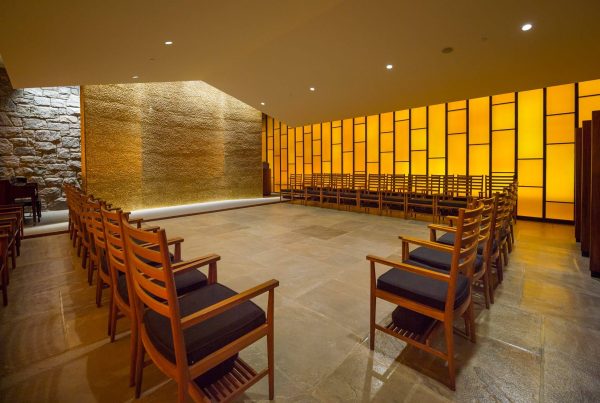The History of Greek Life
After Colgate was founded in 1819, it existed only 37 years as a small, private, all-male institution before the first fraternity was chartered in 1856. This first fraternity was predated by other social organizations.
The Beginning
First, there were literary societies: Gamma Phi was founded prior to 1833 and Pi Delta probably originated in 1834.
According to Howard D. Williams’ summary A History of Colgate University, “competition between them for members led to faculty intervention, with the result that both seem to have dissolved in 1840 when the Adelphian and Aeonian Societies came into existence.”
These met in the attic story of the present East Hall and devoted weekly meetings to orations and readings of original work, on which the groups’ elected critics passed judgment.
The fraternity movement grew out of these literary societies. In 1843 some students petitioned the faculty to let them form a secret society, but “the faculty informed them that, though they found nothing to disapprove in the avowed objectives and deemed the character of the petitioners sufficient assurance that they would hold to those objectives, they considered such an organization ‘inexpedient.’ The fundamental objection was the feature of secrecy which the professors felt might be abused in the future and which “would constitute an undesirable distinction among the members of the Institution, and give pain to many of its patrons and friends,” Williams wrote.
The University’s Laws of 1853 solidified this, stipulating that students “shall form no organizations … except with the consent and under the direction of the faculty and … shall not become members of secret societies.” Some students decided to go behind the administration’s back and were initiated into Phi Upsilon at Hamilton College. But some students still sought a fraternity on the Colgate campus: with the help of a few associates Caleb H. Gallup, class of 1856, secretly petitioned Delta Kappa Epsilon (DKE) for a charter, which was granted by the parent chapter at Yale in March of 1856.
The new DKEs denied all knowledge of their organization, knowing that they faced expulsion if they were discovered. By the next fall, their existence was no longer a secret, and in December 1856 the faculty agreed that the rule against secret societies should be enforced and tried to convince the DKEs to disband. For several years DKEs found creative ways to avoid permanently disbanding, and continued to grow in strength and numbers. They operated alongside and within the Aeonian and Adelphian societies, which were still in existence. To counterbalance the influence of the DKEs a group of students formed an anti-secret society in November 1865, which received a charter as a chapter of Delta Upsilon (DU) the next year.
Establishment and Values
By 1894, each of the existing groups was living in its own house, the first of which was completed in 1882 by DU. Other fraternities in existence at the time were DKE, Beta Theta Pi (Beta), Phi Kappa Psi (Phi Psi) and Phi Gamma Delta (Phi Gam).
“Phi Psi built a house on the corner of Charles and East Pleasant streets which later became the University Infirmary. The Beta’s (the former Adelphian Society, chartered in 1880) rented the old President’s house in 1893 and the Phi Gams lived on Madison street,” wrote Tim Mansfield, current director of Alumni Affairs and former Greek Advisor, in his manual on the history of Greek Life at Colgate.
By this point, the general opinion among faculty of the merit of fraternities had shifted.
“Though there were some who questioned the value of fraternities, especially because of the bitter rivalry among them which was occasionally to be found, they were generally held to be a highly desirable feature of campus life,” Williams wrote.
Fratenities were seen to promote scholarship and intellectual interests, support high standards of discipline and develop courtesy and gentlemanly conduct. By 1894, approximately half of the University’s student body was living in fraternity houses.
In the early 1900s, six Greek letter fraternity chapters were chartered, adding to the existing five: in 1912 Theta Chi, in 1916 Lamba Chi Alfa, in 1917 Alpha Tau Omega, Sigma Nu and Kappa Delta Rho, and finally in 1918 Phi Delta Theta (Phi Delta).
Many of these groups were started as non-Greek organizations before their charters were approved; for instance, the “Owl’s Club” was founded in 1907, became Sigma Alpha in 1908 and was only chartered ten years later as Phi Delta. This increase in fraternities was meant to accommodate social, dining and residential needs of a growing student body.
In the 1920s and 30s fraternity life thrived at Colgate. Sigma Chi, chartered in 1930, and Phi Kappa Tau, chartered in 1937, were added to the mix, and nine of the original 11 fraternities were able to construct new houses with the help of alumni.
In 1928 Colgate alumni formed the Interfraternity Alumni Council under Frank M. Williams, class of 1895, to provide help to local chapters. In 1934 an investigation by a Trustee Committee was initiated due to issues with rushing and pledging procedures.
It concluded that rushing and pledging procedures should be deferred until the end of the first year due to the inability of fraternities to accommodate as many students as wished to be a part of Greek Life.
Counter-culture groups, bodies of non-fraternity men who had formed organizations to meet their own social needs, sprung up around the same time. In 1927 they established a permanent group known as the Colgate Commons Club under Edward M. Vinten, ’28. It had exclusive use of the West Hall lounge.
Greek Life Goes Co-Ed
1970 saw the first women admitted to Colgate in the first-year class and housed in University residence halls. Women-interest housing began to emerge with initiatives such as the Frances Payne Bolton House in 1976, an upperclassmen residence “established to provide functions and activities centering on women’s programs and interests,” as it is written in the chronology.
In 1978, the Phi Psi fraternity added women residents to the third floor of their house, who participated in the boarding and social but not the fraternal aspects of the organization. In 1982, a chapter of Gamma Phi Beta (Gamma Phi) was chartered at Colgate, making it the first sorority on campus, followed by four others: Kappa Alpha Theta (Theta) in 1988, Kappa Kappa Gamma (Kappa) in 1989, followed by Pi Beta Phi (Pi Phi) and Alpha Chi Omega.
Pi Phi resigned in 1992 due to a growing inability to attract new members; they received only seven that year. Alpha Chi Omega voted to relinquish their national charter as Delta Delta Delta (Tri Delta) was chartered in 1996.
There were then four active sororities on campus until the fall of 2008; on October 1 of that year an article by Geoff Guenther in the Maroon-News explained that “Colgate’s chapter of Kappa Alpha Theta has received a four-year suspension in response to an incident of alcohol-related hazing that occurred on September 16.”
The reduced number of sororities raised concern for over-crowded classes in the subsequent year’s recruitment.
In Recent History
In 1989, a Special Committee on Residential Life submitted a report including resolutions voted on by faculty concerning Greek Life to the Colgate University Board of Trustees. This document reported, “The Faculty of Colgate University recommends that the fraternity and sorority system be abolished by the beginning of the academic year 1994-5”. It cited that “the history of fraternities at Colgate reveals a persistent and pervasive pattern of violations of the rules of the University,” and that such organizations “challenge the principals of an open liberal arts education, and foster an environment antithetical to the values and aspirations of the University.”
A drastic change was finally put into motion by the administration in 2003, as part of University President Rebecca Chopp’s new Residential Education Program based on the research and recommendations of yet another task force that studied Colgate’s campus culture. Though it currently stands that the school owns each of the nine active sorority and fraternity houses on campus, “All of these houses used to be owned by alumni corporations of each organization,” Mansfield explained.
Part of Chopp’s plan was to have the University buy Greek Life houses and try to integrate and regulate the community to ensure it was not separate from the rest of campus life at Colgate.
This task force was put together for many reasons, one of which being the tragic one-car alcohol-related crash on Oak Drive on November 11, 2000 which took four lives and sent one student to jail for vehicular manslaughter.
“The car accident, among other things, inspired the creation of a task force to examine campus culture, particularly with regards to alcohol. But this reexamination was also due to factors such as the transition between presidents and the creation of a larger mission statement,” Mansfield said.
“It would have been really easy to consider the outcome of the fraternities differently. It would have been easy to say ‘let’s shut them down.’ The idea of buying the houses and trying to strengthen the system was a bold commitment, and an endorsement of the alumni voice and interest,” Mansfield said.
Part of the motive for preserving Greek Life at Colgate is the rich tradition it has on campus.
“A big part of coming to Colgate is that it’s a place that has a very rich residential life, and this of course includes Greek Life,” Associate Vice President and Dean of Students Scott C. Brown said. “I think, in general, [Greek Life] has always been a very important feature of Colgate.”
The University’s recent purchase of Greek houses was met with resistance by several groups, however; of the nine fraternities and four sororities on campus, only DKE refused to sell. DKE was thereby forced to discontinue its Colgate chapter. Other alumni corporations did sell back, but stated later that they felt they had been unjustly manipulated. Kappa Delta Rho (KDR) and Alpha Tau Omega (ATO) had already been suspended when the sale of Greek Houses was made mandatory.
A website for a group called Students and Alumni for Colgate, found at the URL http://www.sa4c.com/legal/PhiDelta.htm, explains that in response to what they refer to as Colgate’s coercive land-grab scheme, “Alumni members of Phi Delta Theta, and Beta Theta Pi filed separate derivative complaints against Colgate University in U.S. Supreme Court, State of New York and County of Madison, in protest of the forced sale of their private properties under threats of economic duress by the alumni boards of directors.”
To credit the success of the University’s buy-back plan, Mansfield points to the fact that once its fraternity corporation saw that chapters were still being allowed to run somewhat autonomously on campus, “ATO eventually did sell back a few years down the line with the specification of requested occupancy of an active fraternity.” Following this specification, Phi Tau moved into the old ATO house.
Many Colgate students carry around urban myths about Greek Life on the Colgate campus. But who can blame them?
Students stay on campus over a four-year period, and are only involved in Greek Life directly for three years at most. Thus, students’ opinions of the progression and pace of Greek Life development can remain skewed.
Compared to over 150 years of water under the bridge for Colgate’s Greek Life system, four years does not amount to very much.









